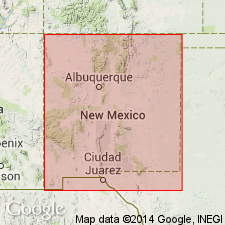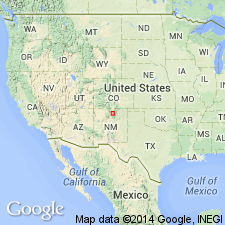
- Usage in publication:
-
- Rio Pueblo Schist
- Modifications:
-
- Named
- Dominant lithology:
-
- Schist
- AAPG geologic province:
-
- Southern Rocky Mountain region
Summary:
Named as an unranked unit in the lower quartzite member of Ortega Formation--is distinct from normal Ortega quartzite. Probably named for Rio Pueblo Creek, 2 mi southeast of village of Rio Pueblo, Rio Arriba Co, NM, Southern Rocky Mountain region, where unit is exposed and extends to south for about 1 mi. Similar rock makes up all of a small hill 1/2 mi northwest of U.S. Hill and northerly part of adjacent larger hill to north. No type locality designated. May represent granitized arkosic quartzite, but appears to consist largely of granitic material intruded into and probably intermixed with quartzite. Resembles a weakly schistose, feldspathic quartzite. Medium grained, of gray-brown, flesh-to-tan, or gray-green color; has a crudely gneissic appearance. Schistose rock exhibits on freshly broken surfaces a matting of silvery muscovite flakes, as much as 2 mm in size, and possesses a streaky foliation. Rock character highly variable, ranging from a gneissic quartz-muscovite-feldspar granulite to a rock resembling a weakly micaceous quartzite. In certain areas, especially south of Rio Pueblo Creek, dikes of granite pegmatite are found partly cross-cutting the schistosity or gneissic foliation of Rio Pueblo. Micaceous quartzite resembling Rio Pueblo is present in extensive outcrops southwest of Pilar. Similar migmatitic quartzite in Petaca region 30 mi northwestward termed Petaca Schist by Just (1937). Precambrian age. Geologic map.
Source: GNU records (USGS DDS-6; Denver GNULEX).

- Usage in publication:
-
- Rio Pueblo Schist
- Modifications:
-
- Not used
Summary:
Rio Pueblo Schist--an unranked unit in the lower quartzite member of Ortega Formation of Miller and others, 1963--not used in Picuris Range area, Taos Co, NM in Southern Rocky Mountain region.
Source: GNU records (USGS DDS-6; Denver GNULEX).
For more information, please contact Nancy Stamm, Geologic Names Committee Secretary.
Asterisk (*) indicates published by U.S. Geological Survey authors.
"No current usage" (†) implies that a name has been abandoned or has fallen into disuse. Former usage and, if known, replacement name given in parentheses ( ).
Slash (/) indicates name conflicts with nomenclatural guidelines (CSN, 1933; ACSN, 1961, 1970; NACSN, 1983, 2005, 2021). May be explained within brackets ([ ]).

